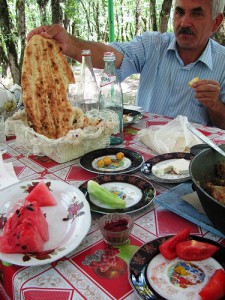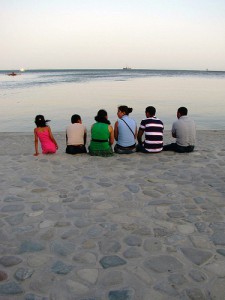- Hey Luigi, wherever you are, here’s news of another map for you to pour (cold water) over.
- New Scientist on nettles that grow at the back of caves and that may be relict populations. Odd.
- Botanic Gardens Conservation International wants children to design “local” floral garlands for olympic athletes. Taking localism too far? What’s wrong with laurel?
- Journalist explores biodiversity vs food security arguments in Ecuador. It’s still complicated.
- Bifurcated Carrots is kind enough to link to the index for Replies to the Online Consultation on the review of the EU legislation on the marketing of seed and plant propagating material. Now, who’s going to do the analysis?
- FAO’s 1964 view of how agriculture would need to change in the following 20 years. Fifty years on, where are we?
- Not so sweet: the Samurais of Sugar.
- In Chicago next month? Go and see a play based on a book based on the scientists at the Vavilov Institute during the siege of Leningrad. Then write us a review?
Nibbles: Vigna umbellata, Afghanistan wheat catalogue, Pingali, Camptotheca, Water stress, Organic Farming for Health and Prosperity
- Crops for the Future finds a nice ricebean project.
- The wheats of Afghanistan.
- A former ICRISAT intern speaks. The world listens.
- Collecting the Happy Tree of China.
- Global water stress maps. Does CCAFS know? Or care?
- Rodale hearts organic.
Nibbles: Graphic agriculture, Nutrition, Climate change, Giant pumpkins, Economic development, Roman millet, Fairtrade, Jojoba and guayule
- Agriculture 101: A graphic novel. Am I the only one who thinks novels aren’t necessarily true? First installment.
- Bioversity has a bunch of factsheets on Nutritious Underutilized Species.
- Why is a cacao tree not like an ATM? Because the ATM still pays out when its hot.
- Speaking of which, big long thought piece on Food Security and Climate Change.
- Giant pumpkins; not much diversity here, except in the agronomic approaches.
- Better access to markets may threaten specialist smallholder farmers. The case of Namibia.
- Ancient Roman ate lots of C4 photosynthesiser: millet!
- Wake up and smell the lack of green coffee.
- A couple of wannabe Mexican industrial crops get some exposure.
Back in Baku
I’ve been travelling so I missed the announcement a couple of days ago on their blog that our friends at CCAFS 1 have a new all-singing, all-dancing platform called the Adaptation and Mitigation Knowledge Network. 2 Which is annoying because the issue of changes in the suitability of the climate for potato cultivation came up in the discussions at the meeting I’m attending here in Baku. And I would quite happily have stolen something else from CCAFS for my presentation. 3 The conference is called “Diversity, characterization and utilization of plant genetic resources for enhanced resilience to climate change” and it was hosted by the Azerbaijan Genetic Resources Institute with support from a number of CGIAR Centres active in the region and FAO, which provided funding for the project of which the meeting is one of the activities.
 There were researchers from pretty much all of the countries of the Central Asia and Caucasus (CAC) region, plus Turkey, Iran, Ukraine and Russia to boot. Many of the presentations brought home to me — and not for the first time — what a tremendously rich part of the world this is for agricultural biodiversity: wild asparagus with stems five meters long; grape varieties sporting bunches almost as long as your arm; strange interspecific wheat hybrids with branched spikes; medicinal plants for every ailment you can think of; wheat landraces phenomenally high in zinc and iron. And that’s just the lunch. Fortunately, the place is also rich in talented researchers busy studying their agrobiodiversity, conserving it, and using it for health, nutrition and food security.
There were researchers from pretty much all of the countries of the Central Asia and Caucasus (CAC) region, plus Turkey, Iran, Ukraine and Russia to boot. Many of the presentations brought home to me — and not for the first time — what a tremendously rich part of the world this is for agricultural biodiversity: wild asparagus with stems five meters long; grape varieties sporting bunches almost as long as your arm; strange interspecific wheat hybrids with branched spikes; medicinal plants for every ailment you can think of; wheat landraces phenomenally high in zinc and iron. And that’s just the lunch. Fortunately, the place is also rich in talented researchers busy studying their agrobiodiversity, conserving it, and using it for health, nutrition and food security.
 Sure, they have problems. Where do they not? But there seems to be a real commitment to getting the job done, enthusiasm even. I was particularly struck by the relatively close linkages between genebanks and breeding programmes in many of the CAC countries. That you certainly don’t see everywhere. I wonder if it’s a legacy of the VIR system. They could do with more collaboration, coordination and sharing of responsibilities at the regional level, not to mention better integration with the rest of the world. But maybe this meeting will help. Anyway, all the presentations, abstracts and final recommendations will be online soon. I’ll post something when they’re up and you can make up your own minds.
Sure, they have problems. Where do they not? But there seems to be a real commitment to getting the job done, enthusiasm even. I was particularly struck by the relatively close linkages between genebanks and breeding programmes in many of the CAC countries. That you certainly don’t see everywhere. I wonder if it’s a legacy of the VIR system. They could do with more collaboration, coordination and sharing of responsibilities at the regional level, not to mention better integration with the rest of the world. But maybe this meeting will help. Anyway, all the presentations, abstracts and final recommendations will be online soon. I’ll post something when they’re up and you can make up your own minds.
Nibbles: Swaziland, Traditional Knowledge, Climate change, Apples, Winged beans, Ambakkadan Cassava
- Queen Mother Ntombi Indlovukazi of Swaziland receives the FANRPAN 2011 Food Security Policy Leadership Award. Her son’s a caution too.
- Summaries of presentations at Informing International Policy on Traditional Knowledge, Mexico 2011.
- CGIAR book on “climate-proofing” crops critical to food security in the developing world.
- Happy Birthday to the McIntosh apple.
- Rhizowen’s winged beans fail to take flight.
- Sharefair hears how women farmers in India resurrected a favoured cassava.
- Sharefair hears dream-team pitch on frike, or as we prefer to say, freekeh.